|
Michael McFadyen's Scuba Diving - Bobbys Wall
The prime diving sites in the Ticao Island/Donsol area are around the San Miguel Island and the other islands near it. This island is at the northern end of Ticao Island. This dive site is located on the eastern side of the island and is normally done when the currents on the are not too strong.
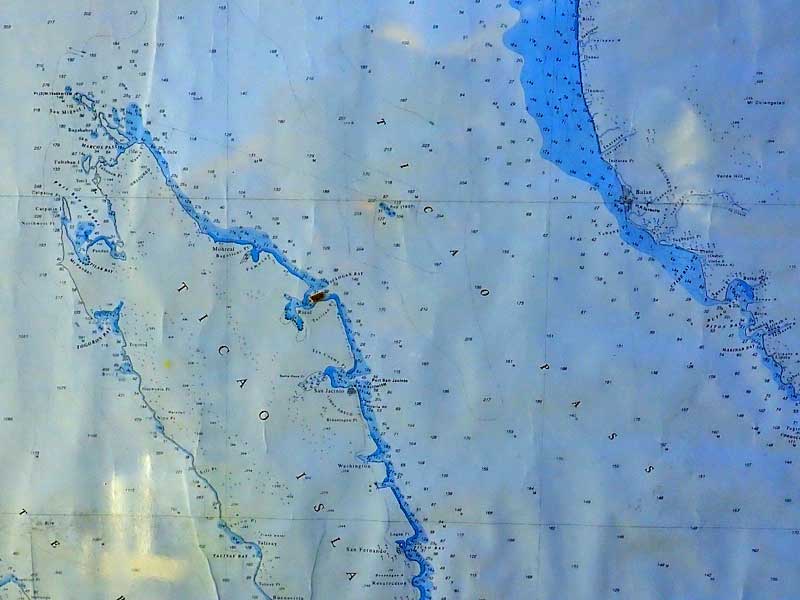 |  |
| San Miguel Island is located at the top left of chart. Ticao Island Resort is near bottom right of island. | An enlarged section of the chart at left. Dive site is top right of island. |
It is about 45 to 50 minutes run from Ticao Island Resort and probably an hour or so from Donsol in a large banca. The dive starts in a small bay near the northern end of the island. In fact, this bay really would appear to have been a pass between two parts of the island, now joined by a sand spit. The bay is quite shallow at about five metres. The bancas anchor in the shallows and after you enter the water, they follow and pick you up wherever you end up. Once in the water, you head north-east and follow the reef edge along the island. Bascially, you head north (at least we did on the three times we dived this site).
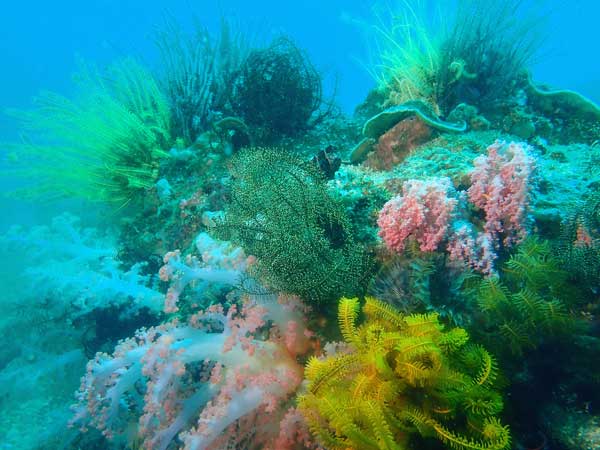 | 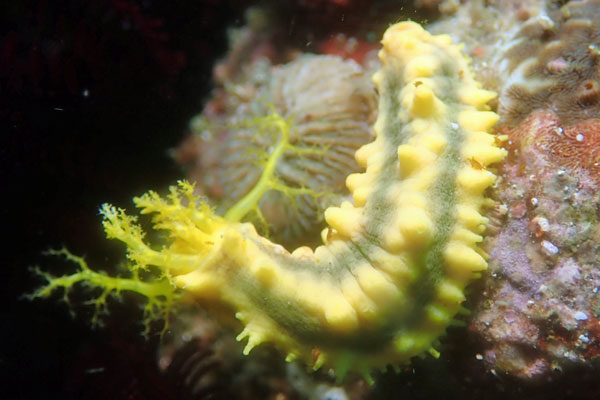 |
| A section of the reef at Bobbys Wall | The yellow sea cucumbers |
On the first section as you drop down deeper the sand area has a few garden eels. I only saw perhaps a half dozen at the most. You will have to be very careful if you want to see them as they scare very easily. On the left the wall is very steep up to the island, but as you go it is less steep.
This dive was also very noticeable for two reasons. First, there were thousands of featherstars all over the place. Secondly, there were tens of thousands of small yellow sea cucumbers. These are everywhere, I have never seen so many in one area.
Further along the reef drops off vertically on the ocean side. It is covered in soft corals of all colours. We get to about 24 metres before starting a gradual ascent as we continue on. The wall eventually becomes less vertical has some flatter areas.
 |  |
| Nembrotha guttata - Orange-pustuled nembrotha | Hypselodoris apolegma - Giant hypselodoris |
We spot a large brown sea horse in a green hard coral tree. This is the second one we see diving around San Miguel Island. Further on there is a very small one, but I cannot get a photograph of it as it is in the middle of a lot of coral etc.
Further on is an anemone with two orangu-tan crabs in it. There are plenty of anemones with clownfish of different species. We also see a couple of pipefish.
There are plenty of fish on this dive, including some nice pufferfish and lots of short-finned and long-finned bannerfish. Of course there are many different species of butterflyfish and smaller reef fish.
 | 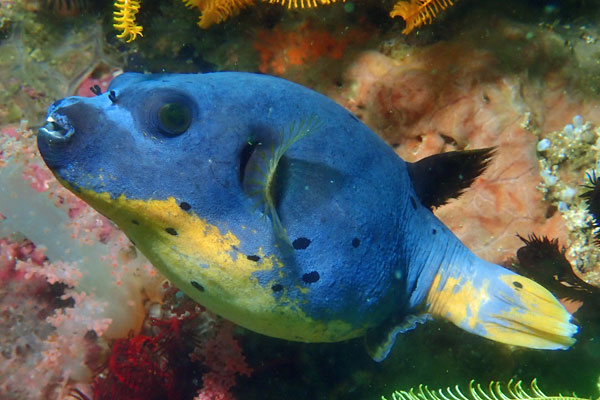 |
| Roboastra luteolineata - bordered roboastra | Pufferfish |
Eventually we end up in the shallows and spend 25 minutes in the 98 to 12 metre depth. There is a lot to see here too. As usual with all the dive sites in this area, there are plenty of nudibranchs, some are spectacular. I have only put a couple on this page, but if you look at the other pages for this area you will see plenty more. At the end of the dive we ascended and the banca collected us.
We did another dive on this wall, starting from where we finished the first dive. For the first dive we probably went about 150 metres, on the second one we only went perhaps 75 metres. There is so much to see.
The wall is again vertical, with plenty of gorgonias and sea whips. After a short distance of the vertical wall, we come to a spot where there are a few caves. The first ones are smaller but the last one is huge with another cave off the back left. This is at about 23 metres. It is very colourful inside and looking out with a wide angle lens (which I do not have) would give some brilliant photographs.
In this area we saw more pipefish, firefish and pufferfish. After spending most of the dive here, we ascend to the area above the cave for our safety stop. It is like a spa in this huge flat area, all the air from inside the cave is seeping through the coral and coming out and bubbling to the surface. Again, we were picked up where we finished the dive.
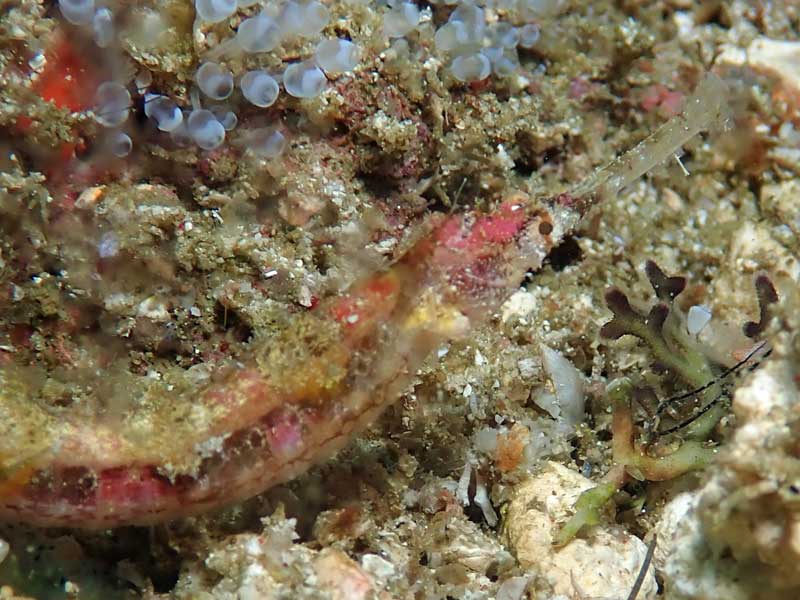 |  |
| Close up of a pipefish | Another pipefish |  |  |
| Sea horse in green hard coral tree | Clownfish in anemone |
I would have liked to keep going past this area as the wall was vertical and covered in more soft corals, gorgonias and sea whips.
Both these dives had very good visibility (20 metres or so) and the water temperature in March was 25.5â°C.
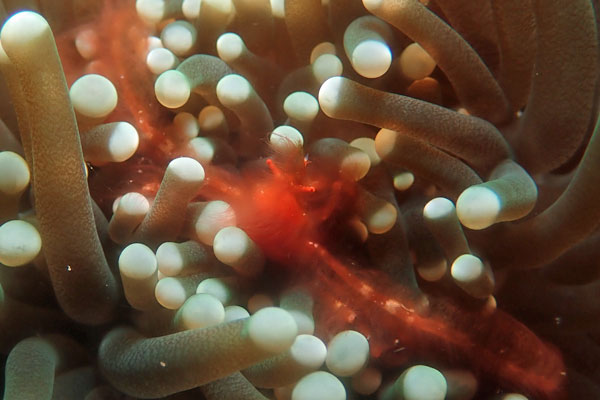 |  |
| Orangu-tan crab in anemone | Looking out from the larger cave |
Click here to return to the Ticao Island dive list.
| 
 v6.00.307 © 2003-2005
v6.00.307 © 2003-2005